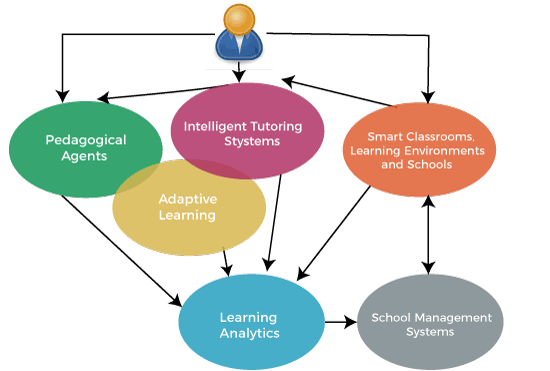The Role of AI In The Education Sector: Revolutionizing Education – 24
The Role of AI In The Education Sector
Artificial intelligence (AI) has become a disruptive force in many businesses in the digital age, and the education industry is no exception. The promise of enhancing learning experiences, personalizing education, and streamlining administrative work through AI integration has inspired a revolution in education systems. This essay explores the role of AI in the education sector, highlighting its advantages and limitations and examining its benefits for both teachers and students.

What is the role of AI in education?
Applications of artificial intelligence (AI) in education are diverse and include tools for administrative automation as well as individualized learning platforms. One of its main responsibilities is to enable individualized learning experiences that are catered to each student’s particular requirements and skills. In order to maximize learning outcomes, artificial intelligence (AI) systems can use adaptive learning algorithms to evaluate student performance data in real-time, spot learning gaps, and provide tailored content and feedback.
Furthermore, the way students receive help outside of the classroom is being completely transformed by AI-powered chatbots and virtual tutors.
By delivering prompt assistance, clarifying ideas, addressing queries, and providing direction for homework, these intelligent systems promote self-directed learning and lessen the workload of educators.
Follow our Digiknowledge.co.in page for the latest updates about bikes, cars, sports, lifestyle, and many more.
What are the benefits of AI for teachers and students?
Artificial intelligence is a useful tool that helps teachers by automating repetitive chores, including creating lesson plans, evaluating tests, and offering insights into students’ development. By releasing more time from administrative responsibilities, teachers may concentrate more on innovative teaching strategies, tailored education, and mentorship, which will ultimately lead to increased student engagement and comprehension.
Contrarily, students gain from AI-driven individualized learning experiences that are tailored to their individual learning preferences and rates of progress. Students can advance at their own pace and gain more confidence and motivation by getting individualized training and fast feedback. Furthermore, by meeting a variety of learning demands, such as those of students with disabilities or language challenges, AI-powered educational tools improve accessibility.
What are the advantages of AI in education?
Scalability and cost-effectiveness are two important benefits of AI in education. AI-driven learning systems democratize access to high-quality education by reaching a large number of students regardless of their location or socioeconomic status. AI also makes it easier for instructors to make data-driven decisions by allowing them to evaluate extensive student performance metrics and modify their lesson plans accordingly.
AI also makes administrative work more efficient by cutting down on paperwork and optimizing procedures like scheduling, enrollment, and resource distribution.
This facilitates smoother operations within educational institutions and saves time and resources, in addition to minimizing errors.
What are the disadvantages of AI in education?
Even though integrating AI in education has many benefits, there are drawbacks and issues to consider. The potential replacement of human teachers by AI-powered systems is one of the main causes for concern.
The complex relationships and empathy that human educators bring to the classroom cannot be entirely replaced by AI, even though it can improve teaching methods.
Because AI systems gather and examine enormous volumes of private student data, there are worries about data security and privacy. Strict security procedures and strong privacy policies are needed to protect this data from breaches and misuse.
Furthermore, if all pupils are unable to use AI-driven resources, there is a chance that educational disparities will worsen. For inclusive learning environments to be fostered, it is imperative to bridge the digital divide and guarantee equitable access to AI-powered educational technologies.
What are the challenges in implementing AI in education?
Artificial intelligence (AI) in education offers a wide range of innovative potential to transform learning processes and results. But in addition to these advantages, there are also big problems that need to be resolved if AI integration is to help all students and teachers. Let’s examine a few of these difficulties:
- Creating Broad Public Policy: Owing to the intricacy of AI technology, it is imperative that laws, universities, and technical standards all be in line with one another. To create an environment that supports the sustainable development of artificial intelligence in education, comprehensive public policies must be established at both the national and international levels.
- To solve shared difficulties and exchange best practices, international collaboration is crucial. While preserving data security, privacy, and ethical considerations, harmonizing laws and standards can help ensure the ethical and responsible use of AI technologies.
- Making Sure There’s Inclusion and Equity: Although AI can improve learning outcomes, there’s a chance it can exacerbate already-existing inequities, especially in less developed nations. Further gaps in access to high-quality education result from these nations’ frequent lack of the technology infrastructure and resources needed to successfully apply AI tactics.
- In order to overcome this obstacle, work must concentrate on developing the most fundamental technology infrastructure and increasing internet access in underserved areas. Initiatives should also give inclusive AI development first priority in order to guarantee that all students, regardless of financial status or location, can use AI-powered teaching resources.
- Teaching professionals to teach with AI: It is imperative that instructors adopt new digital skills and pedagogical approaches in order to integrate AI into the classroom. This calls for a paradigm shift in teaching practices. To monitor student data, tailor lessons, and create collaborative learning spaces, teachers need to be able to use AI tools efficiently.
- Training programs for educators should be designed to provide them with the abilities and information they need to incorporate artificial intelligence into their lesson plans. AI developers also need to work closely with educators to comprehend their requirements and preferences in order to co-design solutions that complement instructional goals and real-world classroom dynamics.
How can AI be used to provide feedback?
Teachers and students can receive feedback from AI. AI, for instance, can be used to give professors and students feedback on their instruction as well as essay criticism.
What is the future of AI in education?
Even though AI is still a relatively new technology, education could be completely transformed by it. Artificial intelligence (AI) is anticipated to be utilized in the future for task automation, student and teacher feedback, and personalized learning. AI is probably going to be used to create new materials and tools for education.
Can AI replace teachers?
In the classroom, AI is unlikely to completely replace instructors. Teachers can benefit from AI’s assistance with activities like delivering feedback, optimizing productivity, and offering individualized materials. But in order to stay in control, educators will need to change, and artificial intelligence cannot take the place of the crucial human interaction and guidance that educators offer.




